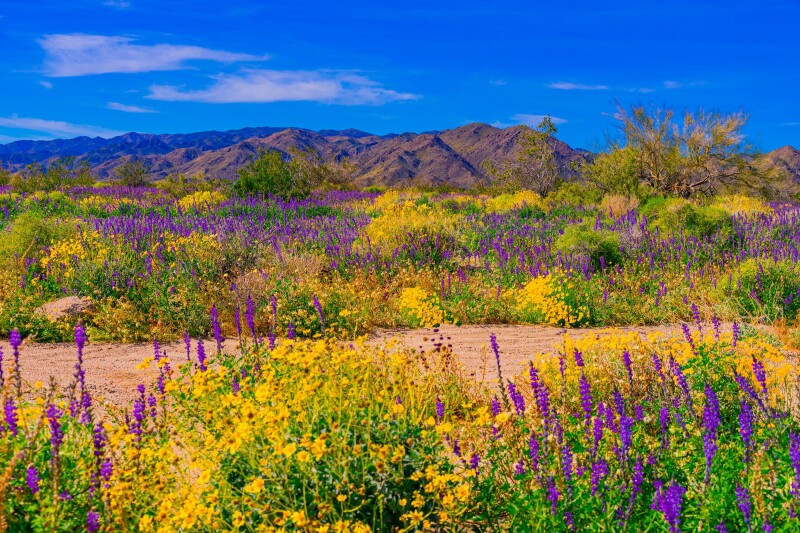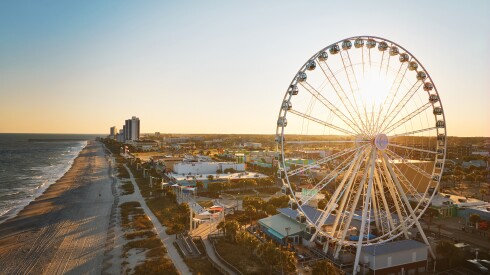California’s nickname is typically thought to allude to the rush of 49ers who traveled west to pan for gold. But some believe that “the Golden State” actually refers to the eye-catching blossoms of the California poppy, the delicate yellow-orange flower that blooms each spring, from Arcata in the north to San Diego in the south.
Peak wildflower season for any given area in California varies from year to year, based on factors such as rainfall, altitude, and temperature. So, it pays to do a little research to find the most up-to-date information and predictions. Previously, rainy years have resulted in spectacular super blooms in 2017, 2019, and 2023.
But will there be another super bloom in the state in 2025? For one to occur, a specific series of events need to happen: A significant amount of rain has to fall in autumn or winter to wash away a dormancy-inducing, bloom-inhibiting chemical from the seeds. Then, there needs to be even more rain, at least once a month, for the flowers to take hold. It takes a few years for a sufficient amount of seeds to collect for a true super bloom, so there likely won’t be the same spectacular display in California in 2025 as there was in 2023. However, spring wildflowers are always a delight, whether there’s a super bloom or not.
Here are the best places to see spring wildflowers across California.
California desert wildflower blooms

One of the best places to see a super bloom in California is at Death Valley National Park—but it happens every 10 to 15 years only.
Photo by Phitha Tanpairoj/Shutterstock
Antelope Valley California Poppy Reserve
- Peak season: Mid-March to late April/May
At this nearly 1,800-acre reserve 75 miles north of Los Angeles, the rolling hills covered in poppies seem to go on forever. Since there was a showstopping super bloom event in 2023, there likely won’t be one this year (though you can call the Poppy Reserve Wildflower hotline at 661-724-1180 or follow the park on Facebook and Instagram for updates). However, Antelope Valley is still the most convenient place to see wildflowers in the Los Angeles area, and the blossoms will surely still be a spectacular sight. Poppies are the stars here, but flowers like desert pincushion, blue dicks, California aster, and blue lupine also grow in the park. And even if you can’t make it out to the park, you can check out the PoppyCam live feed online.
Anza-Borrego Desert State Park
- Peak season: Mid-February to mid-May
The largest state park in California (600,000 acres), located about 85 miles northeast of San Diego in the Colorado Desert, comes alive during wildflower season with desert marigold, desert lily, sand verbena, desert sunflower, apricot mallow, five-spot, Orcutt’s woody aster, and blooming cacti. It’s too soon to tell if there will be a super bloom event this year; check the park’s wildflower hotline for regular updates.
Death Valley National Park
- Peak season: February to July
Without a doubt, the holy grail of California wildflower events is considered to be the Mojave Desert super bloom, which famously occurs in Death Valley and usually happens only every 10 to 15 years (the last two were in 2016 and 2005). When things go perfectly, desert wildflowers at lower elevations—including the valley floor at Death Valley—will begin to appear in mid-February and last until mid-April. At higher elevations, above 5,000 feet, visitors will typically see flowers well into June and July.
“The most impressive are the blooms at low elevation, because of the contrast between rocks and the flowers,” says Abby Wine, a spokesperson at the park. “By far the most numerous flower during a super bloom is the desert gold, which looks like a gold daisy, so there will be big fields of yellow.” Other flowers include the fragile white “gravel ghost” and purple phacelia.
Death Valley National Park did not receive enough early season rains to produce a super bloom in recent years. And although young sprouts have already been spotted across the park, particularly in the low-lying areas which tend to collect more water, the National Park Service has already said that “due to extreme heat last summer/fall and very little rain this winter, we do not expect a good wildflower bloom this spring at low elevations.

When a super bloom takes place in Joshua Tree National Park, it’s a sight to behold.
Patricia Elaine Thomas/Shutterstock
Joshua Tree National Park
- Peak season: January to Mid-April
One of the state’s most-visited parks, Joshua Tree National Park is about a 3.5-hour drive from Los Angeles. Here, visitors can experience arguably one of the most unique and colorful wildflower displays in the country, which features an array of desert plants, including prickly pear, evening primroses, Mojave asters, and desert paintbrushes. The park tends to be busiest around March and April, when blooms are at their peak. However, flowers in higher elevations generally don’t appear until June—so you might want to plan a trip to the park later in the year.
Mojave National Preserve
- Peak season: Mid-February to mid-May
Mojave National Preserve is a vast, otherworldly expanse tucked between Interstates 15 and 40 in Southern California, where sand dunes, volcanic cinder cones, Joshua tree forests, and rugged mountains collide in one surreal landscape. Here you’ll see waves of desert gold, sand verbena, Mojave asters, and evening primrose blanketing the desert floor.
Central Coast wildflower blooms
Channel Islands National Park
- Peak season: Mid-February to mid-May
The five islands that make up Channel Islands National Park, 25 miles off the Santa Barbara coastline, enjoy a breadth of wildflower offerings. On Anacapa, Santa Barbara, and San Miguel Islands, yellow coreopsis begin blooming in January, with flowers usually lasting through March. The rare, butter-yellow, soft-leaved Indian paintbrush is endemic to the Channel Islands but is typically only found on Santa Rosa Island these days. San Miguel is also home to lupine and poppies, while Anacapa features vibrant red paintbrush and island morning glory. Santa Barbara Island also blossoms with lavender chicory and pale-yellow cream cups.
Figueroa Mountain Recreation Area
- Peak season: Mid-March to mid-May
In late March, Figueroa Mountain Recreation Area (about 50 miles northwest of Santa Barbara) and nearby Grass Mountain begin bursting with wild hyacinth, shooting stars, buttercups, milkmaids, Johnny jump-ups, chocolate lilies, scarlet Indian paintbrush, goldfields, purple fiesta flowers, popcorn flowers, and poppies.
Pinnacles National Park
- Peak season: Mid-March to late April/May
This underrated national park, about an hour’s drive southeast of Monterey, typically starts seeing wildflowers in March and reaches its peak in May, when more than three-quarters of the park’s flowers are in bloom. Depending on rainfall and temperature, the first-comers include milkmaids, shooting stars, and Indian warriors, followed by California poppies, bush poppies, fiesta flowers, monkey flowers, baby blue eyes, and bush lupine, and finally the heat-loving clarkias, orchids, penstemon, and roses.
Northern California wildflower blooms

Wild blue lupine blooms around Lake Tahoe in the late spring.
Photo by Ophelia193/Shutterstock
Eastern Sierra Mountains
- Peak season: Late May to June/July
Northern California’s spring blooms begin around Mono County as early as late May, and often last until late June and July. Places like Tioga Pass in Yosemite, Bridgeport Valley, McGee Creek, and Parker Bench are home to every hue in the color wheel. Keep your eyes peeled for orange tiger lilies, yellow mule’s ears, golden mustards, scarlet gilias, blue lupines, purple wild irises, and rosy desert peaches, to name a few.
Lake Tahoe
- Peak season: Late April to June/July
Once the snow melts on the mountains surrounding Lake Tahoe, the valleys and slopes come alive with a flush of colors, from white phlox and Mariposa lily to yellow plantain buttercup, blue lupine, bright-red snow plant, orange paintbrush, and lacy pussypaws.
Lassen Volcanic National Park
- Peak season: Late May to June/July
The timing of Mount Lassen’s snowmelt varies from year to year depending on temperature and the size of the snow pack, but some snow and ice can stick around well into summer, making for a late wildflower show. Lower elevations often don’t see blooms until late May to early July, and at higher elevations, wildflowers appear well into August and September. Look for mountain mule’s ear, pussypaws, snow plant, western wallflower, corn lily, and lupine.
Mount Diablo State Park
- Peak season: Mid-March to late April/May
The state park surrounding this 3,849-foot peak about 40 miles east of San Francisco usually begins blooming with flowers in early March. Here, visitors can see blue skullcaps, Fendler’s meadow-rues, saniculas, Johnny jump-ups, bush lupines, monkey flowers, globe lilies, California poppies, bird’s eyes, and wallflowers.
Mount Tamalpais State Park
- Peak season: Mid-March to late April/May
Mount Tamalpais State Park, just north of San Francisco, offers a slew of trails, ranging from ferny forest paths to ridgeline scrambles with panoramic views. In the spring, those trails are lined with wildflowers California poppies, sky lupines, Indian paintbrushes, and Calypso orchids, to name a few.
North Table Mountain Ecological Reserve
Peak season: Mid-March to late April/May
North Table Mountain Ecological Reserve encompasses a wide-open, 3,200-acre mesa near Oroville. It’s a favorite destination for wildflower lovers and usually hits its peak around late March to mid-May, when visitors can wander among lupine, foothill triteleia, Sierra primroses, blue dicks, purple owl’s clover, and, of course, poppies.
Trione-Annadel State Park
- Peak season: Mid-March to late April/May
This Sonoma County park’s mix of volcanic rock outcrops and forested trails makes for diverse habitats—and even more variety in blooms. Here you may find California poppies, lupines, buttercups, orange bush monkeyflower, and blue-eyed grass, plus harder-to-find species like fritillaries and shooting stars.
This article originally appeared online in April 2018, and was most recently updated on March 24, 2025, to include current information.











